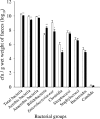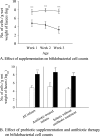Effects of Bifidobacterium lactis Bb12 supplementation on intestinal microbiota of preterm infants: a double-blind, placebo-controlled, randomized study
- PMID: 16971641
- PMCID: PMC1698302
- DOI: 10.1128/JCM.00767-06
Effects of Bifidobacterium lactis Bb12 supplementation on intestinal microbiota of preterm infants: a double-blind, placebo-controlled, randomized study
Abstract
The gastrointestinal microbiota of preterm infants in a neonatal intensive care unit differs from that of term infants. In particular, the colonization of preterm infants by bifidobacteria is delayed. A double-blind, placebo-controlled, randomized clinical study was performed on 69 preterm infants to investigate the role of Bifidobacterium lactis Bb12 supplementation in modifying the gut microbiota. Both culture-dependent and culture-independent approaches were used to study the gut microbiota. Bifidobacterial numbers, determined by fluorescence in situ hybridization, were significantly higher in the probiotic than in the placebo group (log(10) values per g of fecal wet weight: probiotic, 8.18 + 0.54 [standard error of the mean]; placebo, 4.82 + 0.51; P < 0.001). A similar trend for bifidobacterial numbers was also obtained with the culture-dependent method. The infants supplemented with Bb12 also had lower viable counts of Enterobacteriaceae (log(10) values of CFU per g of fecal wet weight: probiotic, 7.80 + 0.34; placebo, 9.03 + 0.35; P = 0.015) and Clostridium spp. (probiotic, 4.89 + 0.30; placebo, 5.99 + 0.32; P = 0.014) than the infants in the placebo group. Supplementation of B. lactis Bb12 did not reduce the colonization by antibiotic-resistant organisms in the study population. However, the probiotic supplementation increased the cell counts of bifidobacteria and reduced the cell counts of enterobacteria and clostridia.
Figures



References
-
- Agarwal, R., N. Sharma, R. Chaudhry, A. Deorari, V. K. Paul, I. H. Gewolb, and P. Panigrahi. 2003. Effects of oral Lactobacillus GG on enteric microflora in low-birth-weight neonates. J. Pediatr. Gastroenterol. Nutr. 36:397-402. - PubMed
-
- Baley, J. E., R. M. Kliegman, B. Boxerbaum, and A. A. Fanaroff. 1986. Fungal colonization in the very low birth weight infant. Pediatrics 78:225-232. - PubMed
-
- Blakey, J. L., L. Lubitz, G. L. Barnes, R. F. Bishop, N. T. Campbell, and G. L. Gillam. 1982. Development of gut colonisation in pre-term neonates. J. Med. Microbiol. 15:519-529. - PubMed
Publication types
MeSH terms
Substances
LinkOut - more resources
Full Text Sources
Other Literature Sources
Medical
Miscellaneous

